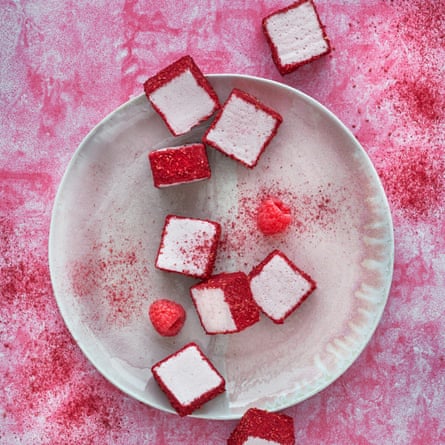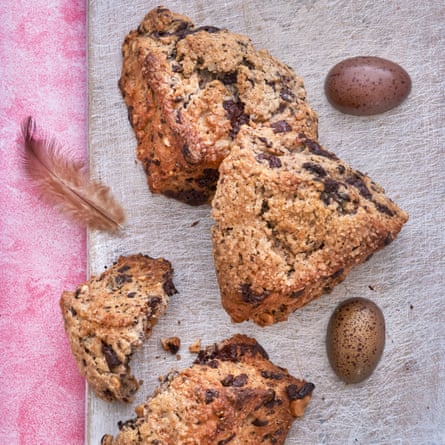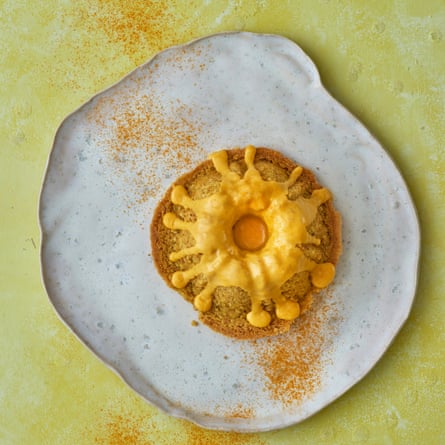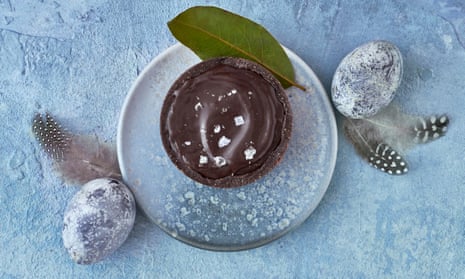In America there’s a tradition of dipping white hen’s eggs into colourful dyes the night before Easter then hiding them in the morning for the children. There is a papier-mache golden egg filled with money to find, as well as other prizes and sweets nestled into secret spots throughout the home. I loved this tradition as a child, racing through the house to find the most eggs before my older brother.
Once the hunt was finished, I always gravitated to the kitchen where Dad was making lunch and Mum was baking. My brother was most likely off to play baseball with his buddies. My mother always made a delicious egg bread that we braided into a large golden loaf.
This year, I’ll be making golden fried dough balls with my daughter. The origin is Nigerian but they are universal in their appeal, so sweet and chewy. I’ve put together some of my favourite flavours for this time of year and tried to make them as colourful and fun as possible. You will benefit from owning an electric stand mixer, but all can be made without one (except the raspberry marshmallows).
Milk chocolate and bay leaf tarts
Milk chocolate bay leaf ganache makes for a truffle-like filling with a crisp cookie crust. My perfect tart. The bay works beautifully with delicate milk chocolate, adding an unexpected layer of complexity.
Makes 6 individual tarts
For the chocolate-almond pastry
unsalted butter 300g
icing sugar 60g, sifted
ground almonds 100g
fine sea salt ½ tsp
eggs 3
cocoa powder 60g
plain flour 380g
For the milk chocolate bay ganache
milk chocolate (preferably 35-40%) 320g, chopped into small pieces
double cream 290g
bay leaves 3 fresh or 6 dried
flaky sea salt to finish
For the pastry, cream the butter on a low speed. Add the sugar and cream a little longer. Add the ground almonds and cream well, but you’re not going for fluffy here, so don’t aerate the butter too much. Add the salt and then the eggs, one at a time, until combined. The mixture may not be smooth but this is fine. Add the cocoa powder just until combined. Add the plain flour in two batches on very low speed, just until it comes together – a moment or so. Do not over mix. Gather into two balls, wrap each ball in clingfilm and chill for at least four hours.
Dough can be kept in the fridge for up to four days or in the freezer for three months. This recipe makes enough dough for two tarts or 12 tartlets, but making a smaller quantity is quite difficult so just make the whole batch and freeze half the dough for another time.
When you’re ready to roll, butter six individual tartlet ring moulds and place them on a parchment-lined baking sheet. I use the rings with no bottoms as they are deep and have nice straight sides, but you could use fluted ones if you prefer. Alternatively, you can make one large tart.
On a well-floured surface, roll one ball out to about 4mm thick. Keep gently lifting the dough to make sure it doesn’t stick, adding more flour as needed. Cut circles of dough slightly larger than your moulds to accommodate the sides. Gently place the pastry over the buttered moulds and press down to fill evenly. Trim the excess from the edges and place the lined moulds into the fridge or freezer for about an hour.
When you’re ready to bake, heat the oven to 180C/gas mark 4. Line each pastry with a piece of parchment and fill to the brim with dried rice, beans or ceramic baking beans. Place in the oven and bake for 20 minutes. Remove the baking beans and paper and bake for another 10 minutes. Set aside to cool.
To make the ganache filling, weigh the chocolate pieces into a heatproof bowl and set aside. Heat the cream in a heavy-bottomed saucepan with the bay leaves, just until it starts to boil, then turn off the heat and cover. Let the leaves steep in the cream for 30 minutes. Remove the lid and heat the cream again (watch cream like a hawk, it can bubble over very quickly and create a mess). When the cream starts to bubble, pour it over the milk chocolate (removing the bay leaves) and let it sit in a warm place in the kitchen without stirring.
After 10 minutes, vigorously whisk together the chocolate and cream until smooth. If some unmelted pieces of chocolate remain, let the chocolate sit for another 10 minutes and whisk again. If you have a cool or draughty kitchen your ganache may solidify before it has properly melted. If this happens, place the bowl over a pan of simmering water for a few minutes, being careful not to overheat.
Pour the ganache into the baked tart shells and give them a little shake to settle the tops. Sprinkle with some flaky sea salt. They can be served immediately or left to set at room temperature, which may take up to two hours.
Raspberry marshmallows

Marshmallows take a little focus and some proper baking equipment, but, oh, what a joy to make and eat real homemade.
Makes about 30 marshmallows
icing sugar 25g
cornflour 25g
egg white 1
raspberries 175g
caster sugar 200g
cold water 180g
powdered gelatin 2 sachets (30g)
vanilla extract 1 tsp
dehydrated raspberries 35g, crushed (or dehydrated raspberry powder)
Grease a 20cm x 30cm baking tray with a little oil. Line with parchment paper and grease again. Whisk together the icing sugar and cornflour and sift over the tray.
In the bowl of a stand mixer fitted with the whisk attachment, place the egg white and set aside.
In a saucepan, heat the raspberries with 25g caster sugar, until they start to bubble and break apart (about 10 minutes). Then push through a strainer to remove all of the seeds. Set aside the puree and discard the seeds.
Put 60g (4 tbsp) water into the bottom of a small, immaculately clean saucepan and add the remaining 175g caster sugar on top of that. Place over a medium heat with a sugar thermometer. Swirl the pan so there are no hot spots but avoid stirring (see tip below). While the sugar is reducing to the hard ball stage (130C) dissolve the gelatin in another small saucepan with the remaining 120g of cold water, then heat it slowly, stirring the whole time until the gelatin is completely dissolved. Turn off the heat and add the raspberry puree and vanilla extract.
When the syrup reaches the the correct temperature, turn off the heat and whisk in the gelatin mixture. Turn the stand mixer on to high and whisk the egg white to medium stiff peaks. Then, with the mixer still going, pour in the gelatin mixture in a slow steady stream. Once all of the syrup is incorporated, keep the mixer on for about 10 minutes until the mixture is almost set and doubled in volume.
Pour into the prepared tin and smooth the top with a spatula. Leave to set for about three hours. Once set, remove from the tin and use a sharp knife to cut into about 24 little marshmallows. Toss in the dehydrated raspberry powder and serve. Keep in an airtight container for up to a week.
Tip
Sugar crystalises very easily, but don’t let this deter you from making this recipe. To avoid this, wash your pan before use and be sure to rinse and dry it well. The water in the bottom of the pan will help to avoid hot spots where the sugar burns so that you don’t have to stir. If you feel you need to stir, swirl the pan rather than stir with a spoon. Once the sugar melts, you can turn the heat up. If you do get some crystals, blast the pan on the hottest heat you have. This should melt any crystals. Good luck!
Pistachio palmiers

I like to mix pistachio and marzipan to make them a little sweeter and add moisture. Palmiers are so versatile you could add almost anything to them.
Makes about 24
shelled pistachios 100g
marzipan 100g
caster sugar for sprinkling
frozen puff pastry 1 sheet (about 300g)
Heat the oven to 180C/gas mark 4. Line a baking sheet with parchment
In a food processor, blitz the pistachios and marzipan into a crumbly powder. Sprinkle a work surface liberally with caster sugar and lay the rolled puff pastry on top of that. Sprinkle again with sugar. Scatter ¾ of the nut filling over the pastry and then roll with a rolling pin to embed it into the dough a bit, without rolling the pastry any thinner really.
With the short side of the rectangle facing you, fold in each of the long sides of dough to meet in the middle. Sprinkle with another layer of caster sugar, cover with the remaining nut mixture and roll again to imbed. Fold the outer edges into the middle again to meet and then fold a final time, giving you a long log of filled dough.
Chill the dough for 30 minutes. Cut the log into 1cm thick slices and place cut side down onto your prepared baking tray about 8cm apart. Bake for 15-20 minutes or until golden.
Hazelnut chocolate chip scones

In America our scones are triangular and filled with delicious flecks of flavour: crystalised ginger and lemon, candied orange and currant, sour cherry, you name it. We bake them for breakfast when friends are visiting and eat them piping hot, steam still escaping. These are especially good for Easter because they are bursting with chocolate pieces. I use dark chocolate but you could use broken up Easter eggs or candy bars for a real sweet treat.
Makes 12 scones
plain flour 420g
caster sugar 70g
baking powder 1½ tbsp
fine sea salt 1 tsp
unsalted butter 110g, cold, cut into 1cm cubes
hazelnuts 65g, toasted and chopped
dark chocolate (70%) 250g, chopped into chunks
double cream 420g, plus extra to brush tops
vanilla extract 4 tsp
demerara sugar to sprinkle
Heat the oven to 220C/gas mark 7. Line two large baking sheets with baking paper.
Place the flour, sugar, baking powder and salt in a large bowl and whisk together well. Cut the butter in with a large fork or pastry cutter until the mixture resembles a course meal.
Toss in the toasted and chopped hazelnuts and the chocolate pieces. Make a well in the middle and pour in the double cream and vanilla. Stir together with a wooden spoon at first, then use your clean hands to break up the larger, wetter pieces, tossing and turning the dough without overworking or kneading it. Once it has mostly come together, turn the dough out onto a lightly floured surface.
Pat into a square and use the palm of your hand to press the dough out about 4cm thick. Fold the dough in half like a book and let it rest for 10 minutes.
Use a rolling pin or your hands to press the dough out evenly into about a 4cm-thick rectangle. Using a sharp knife or bread knife, cut the dough in half lengthways, then cut each length into three equal squares.
Cut each square into two triangles, brush with a little double cream and sprinkle with demerara sugar. Place on two baking sheets and bake for 20-25 minutes until set in the centre and golden brown.
Serve warm with your favourite jams and spreads for a delicious Easter breakfast. Scones that don’t get eaten at breakfast can be split and filled with jam and clotted cream for tea time.
Sweet almond turmeric cakes

Turmeric has had a good year. I can’t deny that its delicious flavour and exquisite colour have won me over as well, and this is one of my favourite bakes using it.
Makes 6-8 individual bundt cakes
For the cakes
unsalted butter 250g
caster sugar 250g
ground almonds 250g
fine sea salt ½ tsp
eggs 4
almond extract 1½ tsp
orange zest from 1 medium
plain flour 120g
baking powder 2 tsp
nutmeg few grates
ground cinnamon ½ tsp
turmeric ½ tsp
whole milk 120g
For the turmeric icing
icing sugar 300g
turmeric 1 tsp
cinnamon ¼ tsp
water 40g
Butter or oil six large or eight regular individual bundt cake moulds. Heat the oven to 180C/gas mark 4.
Cream together the butter and sugar until fluffy and pale in colour. This could take up to 10 minutes of constant beating. Add the ground almonds and mix well. Add the salt and then the eggs one at a time. Add the almond extract and then the orange zest.
Weigh out the remaining dry ingredients and whisk together to combine. Add half to the butter mixture and mix just to combine. Add all of the milk and mix well. Add the remaining flour mixture just to combine. Scrape down the sides of the bowl and mix again.
Fill the prepared tins ¾ full and bake for 25-30 minutes until golden and springy. Cool for 10 minutes before turning out of the tins. Cool completely before icing.
Make the icing by putting all the ingredients into a small bowl and whisking until combined. Drizzle over the bundts and serve.
These cakes store well in an airtight container for up to four days.
Nigerian puff puff

I first tried these, admittedly, because the name is so cute, but I have become obsessed with the simple, sweet, yeasty fried dough. You could roll them in caster sugar or fill them with custard but they are delicious as they are.
Makes about 12 puffs
plain flour 500g
dried yeast 2 sachets (14g)
caster sugar 200g
water 480g
vanilla paste 1 tsp, or scraped seeds of two pods plus 1 tsp extract
vegetable oil 2 litres, for frying
Thoroughly combine all of the ingredients except the oil with a whisk or stand mixer, cover and let rest for two hours.
Heat the oil to 190C, in a deep-fat fryer, Dutch oven or deep-sided pot. Have a plate ready with paper towels to absorb the grease.
Drop ice-cream-scoop-sized dollops of dough into the hot oil and wait for them to puff, then flip over with slotted spoon. Rotate in the hot oil until evenly golden brown. Serve immediately.
Claire Ptak is the owner of Violet Cakes, 47 Wilton Way, London E8 3ED; violetcakes.com
